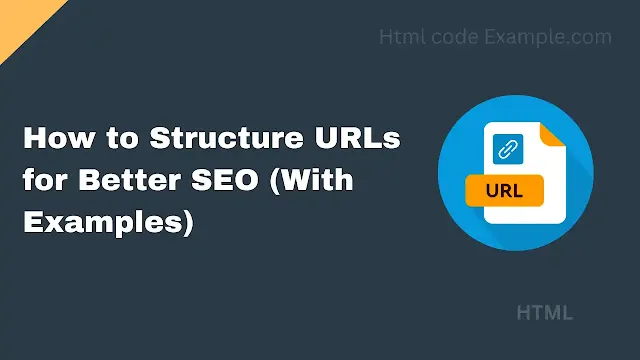If you've ever wondered, "Does the way I write my URLs really matter for SEO?" the answer is a big YES.
URLs may seem like a small part of your website, but they actually play a key role in how search engines and people understand your content. In this post, we'll walk through how to structure your URLs in a way that helps your site rank better—and keeps your visitors happy, too.
Let's break it down.
Why Do URLs Matter for SEO?
Before we dive into the how, let's look at the why.
Search engines use URLs to understand page content. When crawlers land on a page, one of the first things they read is the URL. If it's clean and descriptive, it gives them a clear idea of what the page is about.
People also look at URLs. A readable URL builds trust. Think about it—would you rather click:
https://www.mysite.com/blog/seo-tips
or
https://www.mysite.com/xr92/?p=23&ref=1?
The first one just feels more legit, right?
Best Practices for Structuring SEO-Friendly URLs
Alright, now to the good stuff. Here's how to craft URLs that are both SEO-friendly and user-friendly.
Keep URLs Short and Simple
Long, complicated URLs can be confusing. Try to stick to the essentials.
Example:
✅www.yoursite.com/how-to-bake-cookies
❌www.yoursite.com/blog/2025/04/30/how-to-bake-cookies-for-holidays-with-10-different-ingredients
Why it works: Short URLs are easier to read, remember, and share. Plus, search engines love clarity.
Use Keywords in Your URL
Including your main keyword in the URL helps search engines associate your page with that term.
Example:
✅www.yoursite.com/digital-marketing-tips
❌www.yoursite.com/post1234
Pro Tip: Don't stuff your URL with multiple keywords—it can look spammy.
Use Hyphens, Not Underscores
Google treats hyphens (-) as space separators, which helps it understand individual words.
Example:
✅www.yoursite.com/seo-best-practices
❌www.yoursite.com/seo_best_practices
Why it matters: With underscores, search engines might read your whole phrase as one long word—not ideal for clarity or ranking.
Use Lowercase Letters
URLs are case-sensitive in some cases. So, it's safer to keep them lowercase to avoid duplicate content or errors.
Example:
✅www.yoursite.com/seo-guide
❌www.yoursite.com/SEO-Guide
Avoid Unnecessary Words or Parameters
Words like "and", "the", "for", or symbols like ?id=123 are usually not needed in a clean URL.
Example:
✅www.yoursite.com/email-marketing-strategy
❌www.yoursite.com/the-best-strategy-for-email-marketing-in-2025
Also, if your site uses dynamic URLs (like ?pageid=5), try using a URL rewriting tool or plugin to make them cleaner.
Use a Logical Hierarchy
Structure your URLs based on your site's content. Think of it like folders in a computer.
Example:
✅www.yoursite.com/blog/seo/url-structure
❌www.yoursite.com/2025/urltips/seo/page1
Why it's important: A logical structure helps both search engines and users understand how your content is organized.
Avoid Keyword Repetition
Stuffing your URL with the same keyword multiple times can do more harm than good.
Example:
✅www.yoursite.com/fitness-training
❌www.yoursite.com/fitness/fitness-training/fitness-tips
Keep it natural—write your URL like you're explaining the page to a friend.
Remove Stop Words (When It Makes Sense)
Stop words like "a," "and," "the," or "of" can often be removed without changing the meaning.
Example:
✅www.yoursite.com/guide-to-seo
❌www.yoursite.com/a-complete-guide-to-the-seo
Just make sure the URL still makes sense and reads well.
Don't Change URLs Without a 301 Redirect
If you ever need to update your URLs, make sure you use a 301 redirect to send search engines and users to the new address.
Why this matters: Changing URLs without proper redirection can lead to broken links and lost rankings.
Avoid Using Dates in URLs (Unless Necessary)
Including the year or date can make your content look outdated over time.
Example:
✅www.yoursite.com/social-media-strategy
❌www.yoursite.com/2022/social-media-strategy
Only include dates if the content is truly time-sensitive (like event pages or news articles).
Let's Put It All Together: Before and After Examples
Here's a quick transformation of a poorly structured URL into a clean one:
Before:
www.myblog.com/2025/05/03/article?id=3489&topic=seo
After:
www.myblog.com/seo/url-structure-tips
Why the new one wins:
- It's keyword-rich
- It's shorter and easy to read
- It reflects the topic clearly
- It improves the click-through rate
What Tools Can Help You Create SEO-Friendly URLs?
You don't have to do it all manually. Here are some tools that can help:
- Yoast SEO (WordPress plugin) – Suggests URL slugs and optimization tips
- Ahrefs / SEMrush – Check how your URLs are performing
- Screaming Frog – Analyze URL structures across your site
- Google Search Console – Monitor and fix crawling issues
Final Thoughts: Treat URLs Like Headlines
If you remember one thing, let it be this: Your URL should act like a mini headline. It should tell both people and search engines what your page is about—in as few words as possible.
By following these tips, you'll create URLs that are clear, relevant, and optimized for search. It might seem small, but in the world of SEO, small changes can lead to big results.
